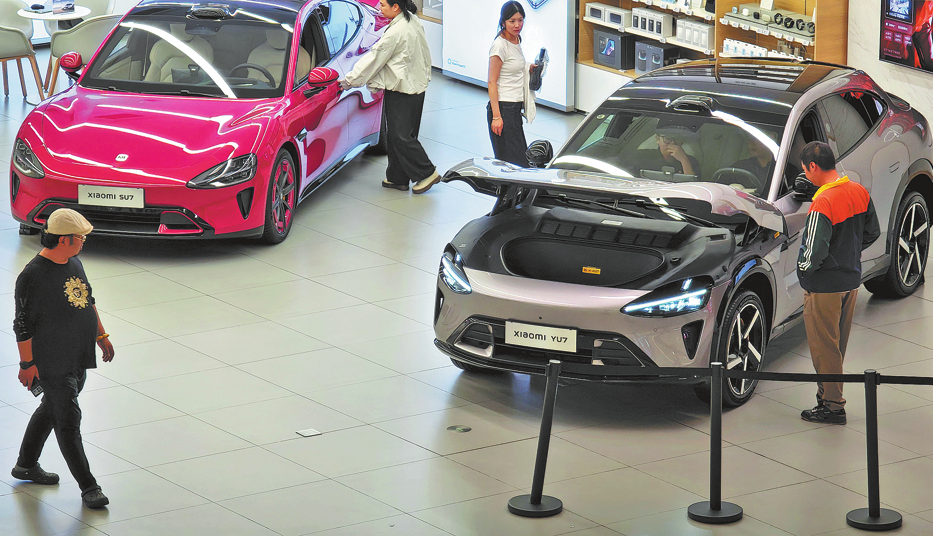Draft rules take aim at automotive safety
Ministry issues new guideline to limit acceleration to reduce accidents


China is racing to tighten safety rules for its automotive sector, with a particular focus on new energy vehicles, as part of efforts to promote the healthy development of the industry.
Among other measures, passenger vehicles would be required to start each journey in a mode where the time from 0-100 kilometers per hour is not less than five seconds.
This is one of the items in a draft national standard issued by the Ministry of Public Security and National Standardization Administration. The draft is now open for public comment and could take effect by 2027.
The release follows a spate of high-profile loss-of-control crashes involving high-performance new energy vehicles over the past two years.
Such accidents usually involve young inexperienced drivers and cars that are apparently too fast for them to steer safely.
Chinese NEV makers have often emphasized performance marketing, particularly 0-100 km/h acceleration figures.
Local brands including Aion Hyper, Xiaomi, and Zeekr have models capable of sprints in around three seconds, while vehicles capable of five-second times are increasingly common.
The draft also introduces new protections in three areas: pedal misapplication, battery system safety, and cabin escape.
For NEVs, which include pure electric and plug-in hybrid cars, it mandates a pedal-misapplication suppression feature: when the vehicle is at rest or creeping, the powertrain must detect unintended acceleration, suppress output, and alert the driver via an audible or visible signal.
Battery safety requirements call for pure electric and PHEV models to automatically cut off the high-voltage circuit if a longitudinal or lateral speed change of 25 km/h or more occurs within 150 milliseconds, or when an irreversible restraint system deploys.
The vehicles must monitor individual battery modules, automatically record and issue warnings of thermal incidents, and provide directed pressure relief through reserved channels so that any battery venting does not compromise the passenger cabin.
For large battery electric buses (6 meters or more), the standard mandates that the external battery pack must resist ignition or explosion for at least five minutes of a battery-alarm event.
Last month, a Li Auto Mega MPV caught fire in Shanghai while driving, prompting the company to recall 11,411 2024 Mega units due to corrosion in the battery pack's coolant system.
On driver-assistance systems, the draft requires vehicles equipped with combined assistance features to use biometric or account login to verify the driver has been trained.
Once active and above 10 km/h, systems must perform continuous hands-off/wheel-contact and gazemonitoring checks — a clear response to misuse of "hands-off" driving kits.
Chinese car buyers are highly receptive to, and sometimes reliant on, these advanced driver assistance systems.
Yet accidents have occurred when drivers overestimate the technology, which at its current stage still requires constant attention and immediate takeover.
Earlier this year, three young people died in a Xiaomi SU7 sedan when the car, cruising at 116 km/h on a highway in Anhui province at night with the Xiaomi Pilot system active, suddenly prompted the driver to take control after detecting an obstacle.
Data shows the driver responded immediately, but the vehicle collided with a concrete barrier at 97 km/h and caught fire.
Following the accident, the Ministry of Industry and Information Technology issued a notice instructing automakers to avoid exaggerating their advanced driver assistance systems capabilities.
The draft also addresses door and escape safety. Each occupant must be able to exit via two separate doors, and all doors must have mechanical release handles even if equipped with electronic latches.
In launch deployments or battery-risk events, non-impact-side doors must automatically unlock and allow opening from outside without tools.
In another incident last month, a Xiaomi SU7 in Chengdu, Sichuan province, caught fire after a collision. Bystanders reportedly could not open the electronic latch, highlighting the risks of advanced door-locking systems.
Analysts say such incidents underline systemic risks in China's fast-growing EV sector, where some manufacturers focus heavily on promotional 0-100 km/h figures and ADAS marketing while safety systems and escape mechanisms lag.
"Automakers must shift from athletic acceleration to everyday safety," said Zhang Xuan, a Shanghai-based automotive industry analyst. "The draft standard reflects a move from ex-post enforcement to ex-ante prevention."




































